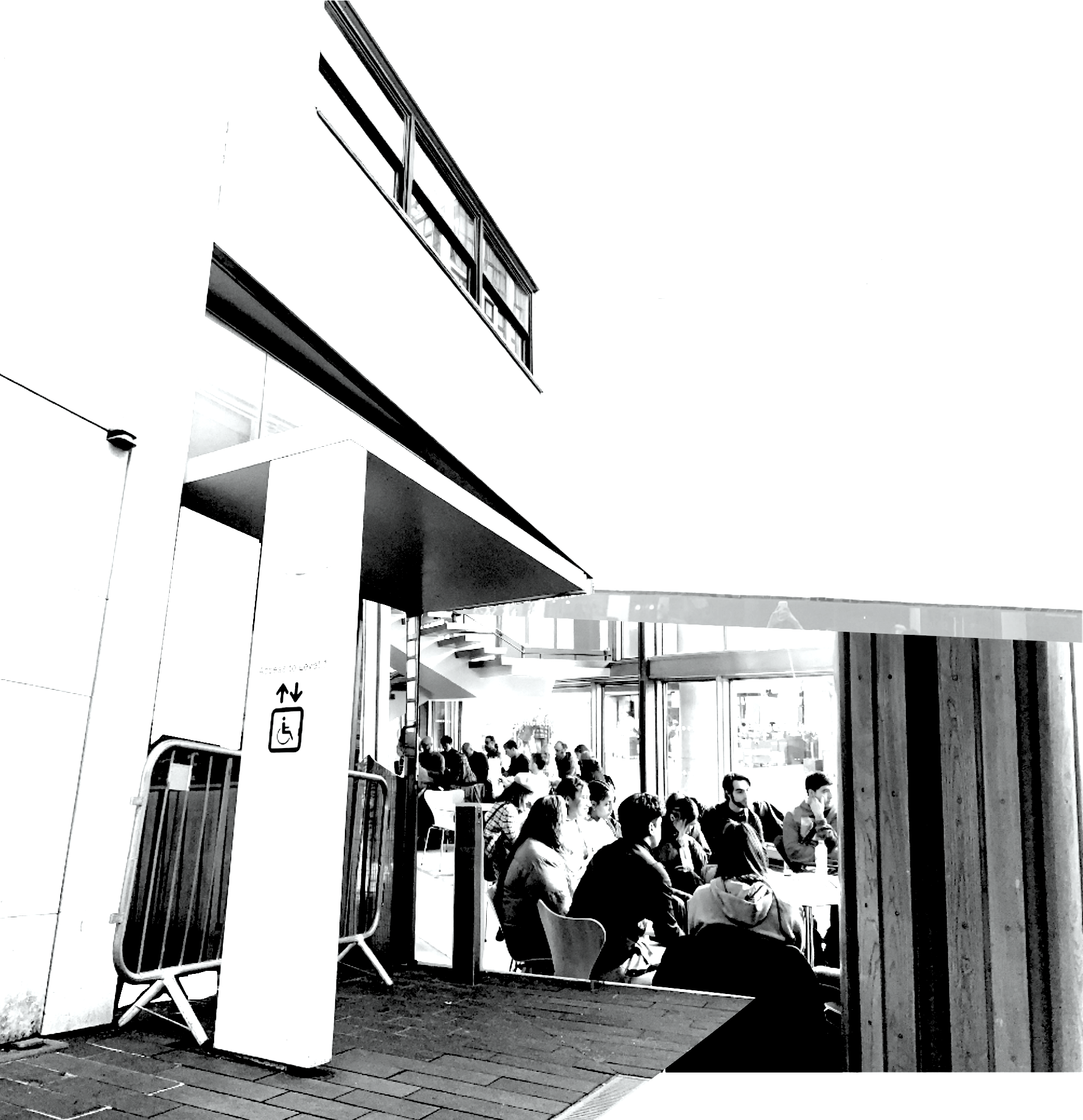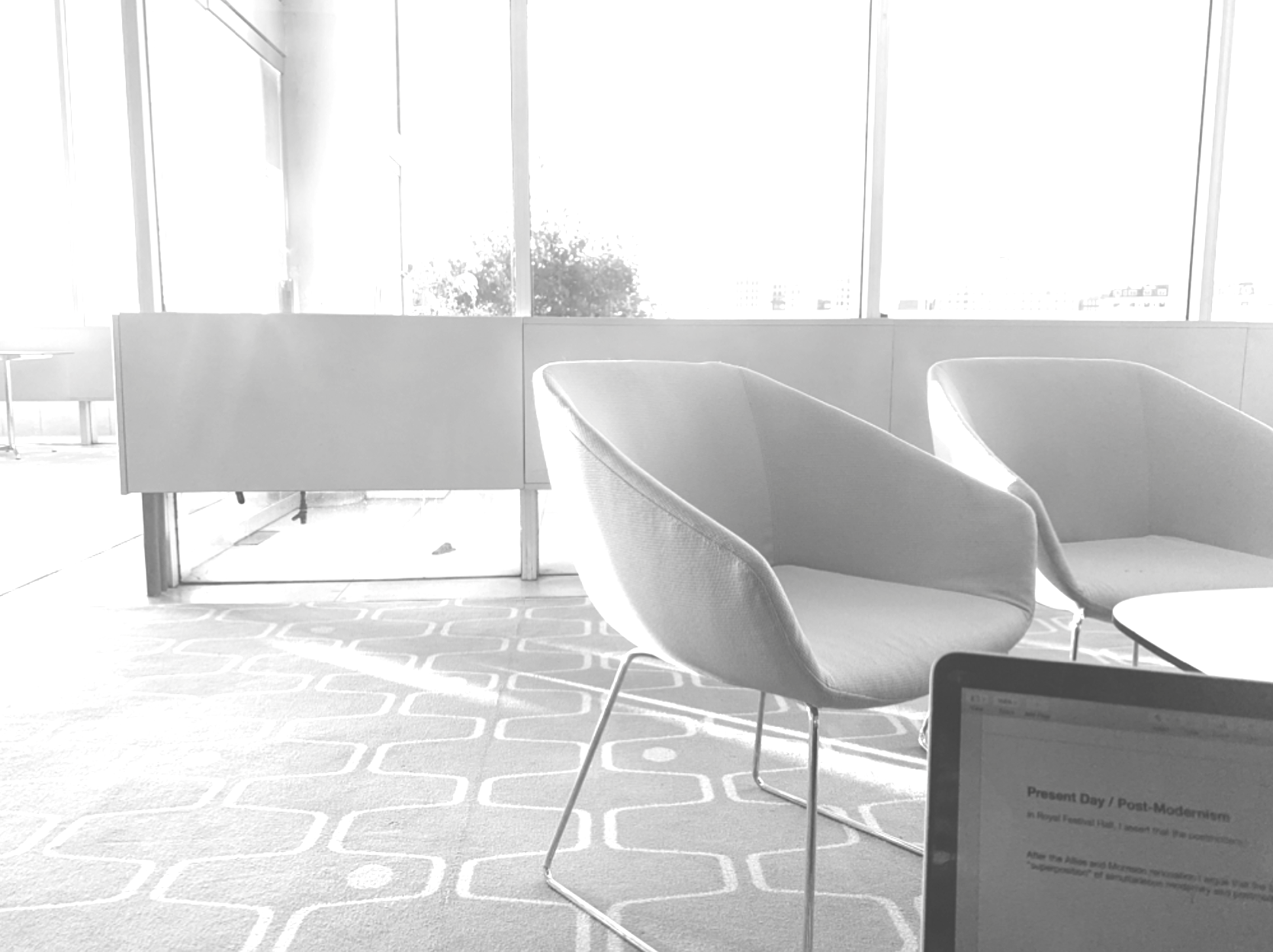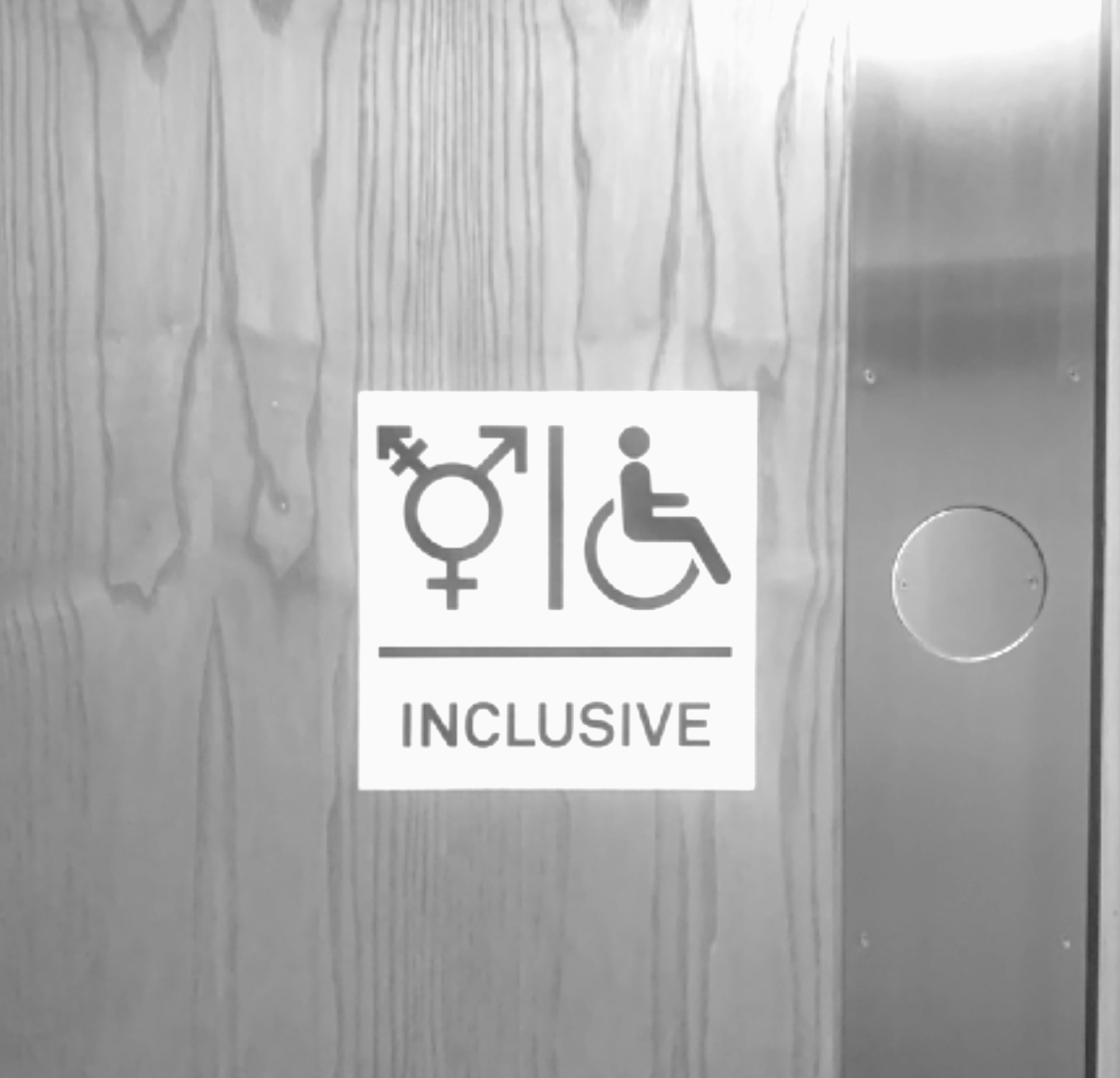Queering the Demos: Trans Femme Flâneur Reflects on Royal Festival Hall
Julæ Lynn-Tanning
→MLA LDAR 2026
Demos [n]: from Ancient Greek δῆμος, denoting the ordinary people and common citizens within a city-state.
 Royal Festival Hall exists not as a static entity but as a shivering, wavering set of social and material superpositions.
Royal Festival Hall exists not as a static entity but as a shivering, wavering set of social and material superpositions.Flâneur / Introduction
“I am made and remade continually.”
English writer Virginia Woolf’s words from her most experimental novel The Waves are clawed on the back cover of my standard issue Singapore Armed Forces notebook.
Her quote is both relevant to my identity as a queer person as well as to the modern condition, which has an uncomfortable relationship with the chaos from which it was formed.
Enlisted into the infantry as a trooper, with much of my agency interred in a shell scrape, I still had paper, pen, and an abject stare.1
“The flâneur now seems to be the most fitting vector for a researcher—puttering about the urban matrix in contemplation of the human condition.”
Introduction / Flâneur
I was determined in a modernist sense to extract the “eternal from the transitory.”2 I observed, I sketched, I read.
Deep within the bowels of the Brunei jungle, I distilled a dialectical mode of inquiry that I carry to this day.
“Why must there be a military?” “To defend Democracy.”
“Defend from whom?” “Outsiders.”
“Why enlistment?” “Because you wouldn’t do it otherwise.”
Sovereignty and coercion, democracy and exclusion, violence and peace, all seem incompatible if not diametric opposites. Yet these shivering, wavering uncertainties exist in volatile superpositions everywhere I look.
The flâneur now seems to be the most fitting vector for a researcher—puttering about the urban matrix in contemplation of the human condition.
 An unabashedly modernist section of the building, featuring full length windows that allow for maximum infiltration of sunlight.
An unabashedly modernist section of the building, featuring full length windows that allow for maximum infiltration of sunlight.
Social Democracy / Context
Royal Festival Hall was initially commissioned by the London County Council (LCC) for the Festival of Britain in 1951 as a 2,700 seat performative arts venue. The radically democratic brief that the LCC pushed for Festival Hall, the egalitarian intentions behind its design, and its historical significance make the site the strongest argument for post-war modernist architecture and an apt site for my reflections on social democratic architecture.
Democracy is an integral element of the building from its conception—the egalitarian openness of the design is intended as a forceful counterpoint to the pre-war exclusivity of modernist architecture.
Festival Hall was an integral element of a festival that celebrated the ordinary person’s contributions to the Second World War. “The people’s war was to be succeeded by the people’s peace.”3
However, to constitute a “people” necessitates excluding an “other” from the same dignities and access as “full persons.” Black people in Britain for instance continue to experience considerable racism after the war, having to build a Black identity against the backdrop of the ossified legacy of slavery within British law and empire. Queer people were also largely excluded from the post-war polis with a significant increase in persecution of men under Section 11 of The Criminal Law Amendment Act, 1885.
 All-gender inclusive signs affixed to accessible bathrooms are a welcome addition to Royal Festival Hall but I avoid using them because of the unwanted attention it calls to my transness in a transphobic political climate.
All-gender inclusive signs affixed to accessible bathrooms are a welcome addition to Royal Festival Hall but I avoid using them because of the unwanted attention it calls to my transness in a transphobic political climate.
Context / Social Democracy
Hobbes argues in the Leviathan that members of a society surrender their liberties to the ruling sovereign in exchange for social order, to evade the “war of all against all,” where life is “solitary, poor, nasty, brutish, and short.”
Festival Hall embodies the post-war social contract between the Fordist and Keynesian social democratic welfare state of post-war Britain and proletariat polis.
Royal Festival Hall in post-war Britain facilitates the radical expansion of access to the performative arts as an integral support of the social reproduction of labour.
“Walking into Festival Hall, a strange feeling descends upon me: I should not be here, yet here I am, and no one is chasing me out.”
In the neoliberal era, Festival Hall has been radically abstracted to suit the needs of global capital. In Undoing the Demos, political theorist Wendy Brown outlines how the neoliberal turn constitutes a reduction of the citizen to homo oeconomicus, a utility maximising abstraction that cedes concerns of justice to the profit imperative and surrenders liberty for its facsimile in the “free marketplace.”4
As British social democracy in the neoliberal era has been eviscerated in favour of radical austerity and deregulation, Royal Festival Hall has been repurposed and renovated to serve the neoliberal city state.
Auto-Ethnography / Social Democracy
Walking into Festival Hall as an ethnically Chinese trans-lesbian who grew up in a former British colony, a strange feeling descends upon me: I should not be here, yet here I am, and no one is chasing me out.
I grew up in Singapore, where discrimination against queer people and specifically virulent trans-misogyny were tangible realities that populated my daily life.
Moving to London, I did not expect any better, particularly with the incessant maligning of trans people on British mainstream media. Combined with the reports of increased hate crimes against Asian people during the pandemic, I was ready to experience some level of violence in London, particularly as I embody the intersection of several marginalised identities.
What I discovered living in London is that racism and transphobia are pervasive but my class often insulates me from the worst of it. My status as an international student with disposable income makes me a potential customer and my marginality therefore is tolerated if not welcomed.
Social Democracy / Auto-Ethnography
“Why does tragedy exist? Because you are full of rage. Why are you full of rage? Because you are full of grief.”5
Do I as a trans woman want to be included into social democracy?
A popular call-and-answer chant at trans protests goes: “Trans Liberation, Fuck Assimilation!”
The call to reject assimilation, or “passing stealth” within cis-heteronormative society recalls the African American writer James Baldwin’s question:
“Do I really want to be integrated into a burning house?”6
Auto-Ethnography / Postmodernism
The brass handrails of the cantilevered wishbone staircases exude a sense of luxury that is radical, even queer, when applied to a democratic space.
"I cast the building as a ‘baby trans’ person, just starting her transition from being a masculine, modernist building to becoming a more effeminate, postmodern one."
My eyes scan along the spare modern walls and smooth over the generously polished wood as it meets the patterned carpets inspired by British designer Lucianne Day’s radical, organic designs for the space. I crumple against the lofty egalitarian aspirations that these precisely juxtaposed textures concretise and scrape by, knowing that my queer, Southeast-Asian body was never intended as a constitutive element of the demos that these textures serve.7
If the postmodern project consists of “incredulity toward grand narratives,” my disillusion with the grand narrative of democracy in Royal Festival Hall was supplanted by a mischievous urge to impose a small queer narrative on its material transformations.
Postmodernism / Auto-Ethnography
Fully aware that the narrative orientations toward my site are tilted by my queer embodiment, I contend that the material transformations of Royal Festival Hall can be perceived as a species of gender transition.
Headlines that variously describe the early 2000s Allies and Morrison refurbishment as a “makeover” and “facelift” personify the building as an aging celebrity undergoing a laboured process to present a more youthful appearance to their audience.
Extending the personification, I cast the building as a “baby trans” person, just starting her transition from being a masculine, modernist building to becoming a more effeminate, postmodern one.
Drawing from Butler’s Performativity Theory, the gender or even genre of Royal Festival Hall is constituted by an iterative and stylised repetition of “acts” across time.8 The modernity or postmodernity of Royal Festival Hall and by extension its identity is not a static reality but a socially constructed superposition that vibrates and blurs with every sited performance.
Festival Hall’s public-facing exhibitions like the “Winter Light” exhibition can thus be perceived as a constitutive element of the building’s identity. Light emanating from the neon light-art installations like American artist Fred Tschida’s “Sphere,” installed in the foyer of Royal Festival Hall alter its space by refracting an orange-red neon glow off the modernist walls and constitutes a step towards a postmodern performance of space.
Function / Spirit
The word “function” in the oft-repeated Modernist adage “form follows function” as coined by the Chicago School architect Louis Sullivan is not a reference to the practical purpose of the structure but its metaphysical essence or destiny, identity, spirit.9
The metaphysical essence of Royal Festival Hall an open, possibly democratic one.
However, I also understand that the link between material form and social outcome is often tenuous, modulated by a plethora of sociopolitical intermediating factors.
The democratic function of Royal Festival Hall necessarily needs to be supported by strong democratic institutions that prioritise the wellbeing of the demos and not just the interests of the ruling elite.
In Militant Modernism, British journalist Owen Hatherley argues that the essence of post-war social-democratic projects like Royal Festival Hall, the National Health Service and the Southampton council housing estates that he grew up on represents a model of utopian modernism that ought to be excavated and revitalised.10
In the contemporary context of constant assault on public institutions by supranational corporate power, the spirit of institutions like Royal Festival Hall need to be strengthened by robust, democratic organising that strengthens public institutions instead of privatising them.
Spirit / Function
The Dutch-American sociologist Saskia Sassen in her book The Global City describes a profound transformation from the 1960s to mid ’80s in the social, cultural, and material makeup of cities. In particular, she names New York, London, and Tokyo as global centres for the newly transformational power of mobile capital and finance.11
Sassen outlines the way in which corporations disperse their industrial processes around the world to minimise labour costs, evade taxes, and take advantage of favourable business climates while consolidating central functions like management, banking, and financial operations in a few sites.
London’s privileged status as a “global city” necessitates a deregulation scramble to attract investors and a competitive transformation of the built environment to support the primary industries of management, banking, and financial services.
Deindustrialization of global cities, precipitated by the outsourcing of manufacturing to developing countries, containerisation, and the sheer profitability of the financial sector also alters Royal Festival Hall’s function.
With an exponential increase in London workers not being able to afford to stay in London and having to commute in from neighboring regions, the Festival Hall’s function of democratic access seems heavily diluted. Instead of serving a working class clientele, Festival Hall has been co-opted in the postmodern era as a piece of “cultural capital” in order to increase the standard of living and attract the “human capital” that drives the financial services sector in London.
Affect / Conclusion
The relational materialities, democratic ideals, and modernist roots of Royal Festival Hall are variously contradictory, ephemeral, and disjointed. In this unstable space, I assert that affect has an indispensable role in parsing the significant and the trivial.
The American philosopher Martha Nussbaum cites the French novelist Marcel Proust to argue that emotions are “geological upheavals of thought.”12 Far from a hindrance of reason, science, or design, emotions, Nussbaum asserts, point us toward what is most important. In the 21st century, social science has undergone a considerable “emotional turn” that echoes Nussbaum’s assertion about the primacy of affect.
I argue for the injection of queer rage into architectural criticism in response to cis-heteronormative society’s devastation of queer access to public space via the policing of queer bodies, the increasing criminalisation of disproportionately queer homeless people, and mounting hate crimes precipitated by queerphobic discourse pushed by the highest ranks of this country’s leadership.
Conclusion / Affect
In “The Lesbian Flâneur,” the feminist academic Sally Munt cites the theorist Susan Sontag who writes that “a lesbian is occupying space as it occupies her. Space teems with possibilities, positions, intersections, passages, detours, u-turns, dead-ends, [and] one-way streets.”13
Writing this piece was a foray into queering democratic discourse about the built environment. I am grateful for this walk.
This piece is reworked from a History and Theory of Architecture dissertation completed in 2022/23 at the Bartlett School of Architecture, University College London, supervised by Dr. Lo Marshall.
Julæ Lynn-Tanning wants to see past the neoliberal post-truth phantasmagoria.

Notes
-
Julia Kristeva, Powers of Horror: An Essay on Abjection (New York: Columbia University Press, 1982).
- Charles Baudelaire, The Painter of Modern Life, first published in Le Figaro, 1863.
- John McKean, Royal Festival Hall (London: Phaidon Press, 1992).
- Wendy Brown, Undoing the Demos (New York: Princeton University Press, 2015).
- Anne Carson, Grief Lessons (New York: New York Review Books Classics, 2006).
- James Baldwin, “Letter from a Region of My Mind,” The Fire Next Time (New York: Dial Press, 1963).
- Lucas Crawford, “The Crumple and the Scrape: Two Archi-Textures in the Mode of Queer Gender,” Places Journal, 2020.
- Judith Butler, Gender Trouble (New York: Routledge, 1990).
- Louis Sullivan, The Autobiography of an Idea (New York: Dover Publications, 1924).
- Owen Hatherley, Militant Modernism (Hampshire: Zero Books, 2008).
- Saskia Sassen, The Global City (Oxford: Princeton University Press, 1991).
- Martha Nussbaum, Upheavals of Thought: The Intelligence of Emotions (Cambridge: Cambridge University Press, 2001).
- Susan Stryker, “My Words to Victor Frankenstein Above the Village of Chamounix: Performing Transgender Rage,” GLQ 1, 1994.